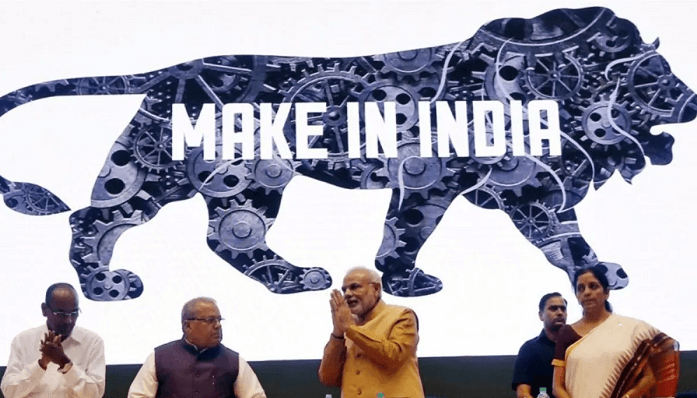Advantages and Disadvantages of Make in IndiaWhat is Make in IndiaOur Prime Minister, Mr. Narendra Modi, used the concept "Make in India" about foreign marketing on September 25th, 2014, at the Vigyan Bhawan Convention Center in New Delhi. The catchphrase was developed to promote domestic production and investments in India by luring clients from all over the globe. 
The goal of such an effort is to boost India's economic growth, make India an independent nation, and give the Indian economy international prominence. It also aims to enforce primary, secondary and tertiary sector job creation. This effort intends to enhance both the quality of the nation's services and the flow of direct investment from abroad by partial privatization of the functions of governmental bodies that are suffering major losses. The objective of Make in India
Purpose of Make in India
"Manufacture in India and sell the goods abroad," is the campaign slogan of 'Make in India'. Why Make in IndiaMaking sure that there is minimal inflation, policies are regular and prediction of inflation is the prime purpose of the Make in India initiative. Additionally, the investors with Make in India would look for stable trade policies, import and export taxes, and taxation. Steps to make 'Make in India' Successful
Make in India InitiativeThe Make in India program's main initiatives include the following:
Problems in ImplementationThe following obstacles hinder the development and implementation of the Make in India initiative.
Advantages of Make in India1. Employment Generation The main goal of Make in India is to generate and offer jobs for everyone, particularly for the nation's younger generation. Sectors such as telecommunications, pharmaceuticals, tourism, etc. generate jobs. Young entrepreneurs will be inspired to apply their creative ideas for the country's advancement by the younger generation. 2. Improvement in Area: The area is also improved. When a factory or an industry is established in a location, it draws customers, workers, and other residents. Together, the neighborhood, its surrounding communities, and the residents of these communities develop. As a result, the families that live close to these places will have a better financial situation. 3. Good for GDP GDP stands for Gross Domestic Product. The level of a country's GDP determines its level of development. The Make in India program will help Indian industries grow, which will increase the Country's income. Developing industries like exporting, architecture, textiles, communication, etc., would strengthen India's economy. 4. Rise in Rupee's Value The value of the rupee will rise as a result of Make in India, which will bring in more foreign direct investment and raise the rupee's exchange rate with the US dollar. Additionally, this will lessen the impact of the dollar's control over the rupee in India. 5. Growth of Native Products A shift from foreign brands to native products will occur. Indian consumers are drawn to international brands and pay little attention to indigenous brands, which hurts local manufacturers. Make in India would help local producers gain recognition for their goods in the nation and start earning a profit. 6. Technological Developments Made in India gives Indians access to cutting-edge equipment. This program stimulates the development of new technology in India. Additionally, strengthening the nation's labor force's abilities is a priority. 7. Simplifying Operations Make in India initiative is an open invitation to all manufacturers operating globally. The government has lifted several limitations to welcome as many firms as possible. The young people of India never have the opportunity to live in a setting where they may hone their abilities and put forward their innovative ideas; as a result, they leave the country in search of better possibilities. Make in India will create the necessary climate within the nation and draw creative ideas from the nation's bright young people. Rural India's development is possible through Make in India. When a factory is built, it not only brings in workers but also stimulates development in the local area. When a factory is built in a remote region, nearby markets, hospitals, and other amenities become available. Disadvantages of Make in India1. Impact on Agriculture Sixty-one percent of India's farmland is devoted to agriculture, making it an agrarian society. However, Make in India promotes industrial growth while excluding agriculture from it. 2. Resource Exploitation Resources are finite by nature, yet human wants are endless. The survival of the population may soon be in peril due to this. The Make in India initiative focuses on growing resource-intensive manufacturing sectors. 3. Loss to Small Entrepreneurs Make in India welcomes foreign nations to its country, and when these nations establish manufacturing facilities, they draw residents to them. This causes a loss to small business owners already working hard to establish their positions. 4. The loss of Arable land The campaign strongly emphasizes the construction of an industrial complex in India. These production facilities can be located anywhere, and occasionally they even use agricultural land. Therefore, Make in India will destroy the value of arable land. 5. Losses to Other Sectors The primary sector, the industrial or secondary sector, and the service sector comprise the three main sectors of the Indian economy. However, Make in India focuses more on the secondary sector, leaving the other sectors in the dust. A complete focus on the manufacturing sector won't lead to economic progress for the nation because the economy cannot develop by developing one sector solely. The pollution index for India is currently 76.50, and after the Make in India Campaign, this number will rise undoubtedly. |
 For Videos Join Our Youtube Channel: Join Now
For Videos Join Our Youtube Channel: Join Now
Feedback
- Send your Feedback to [email protected]
Help Others, Please Share










